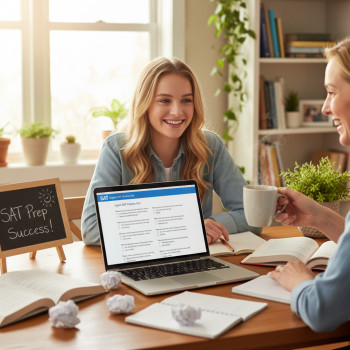Why Peer Influence Shapes Your Digital SAT Success
When you think about SAT prep, what pops into your mind? A stack of practice tests? A dusty math notebook? Maybe evenings spent scrolling through practice questions on an app? Those images are familiar—but there’s one invisible force that quietly changes the way students prepare and the outcomes they achieve: peers. Your classmates, friends, and study buddies don’t just sit beside you while you study—they influence your goals, your habits, and your results.
The surprising power of peers
Humans are social creatures. From classrooms to sports teams to online groups, we pick up behaviors, attitudes, and expectations from people around us. For students preparing for the Digital SAT, peer influence shows up in small ways (the decision to do an extra practice set tonight) and big ones (choosing a test date, selecting study resources, or deciding whether to hire a tutor). These influences can tilt outcomes in either direction—lifting grades and motivation, or creating stress and comparison traps.
How peer effects actually work
Think of peer influence as a nudge rather than a shove. It operates through:
- Norms: If most people in your school take timed practice tests every weekend, that behavior becomes the norm and you’re more likely to do it too.
- Motivation contagion: Enthusiasm spreads. A study buddy who celebrates small wins makes it easier for you to keep going.
- Social comparison: Comparing scores or study time can either inspire you or make you feel discouraged—depending on the context.
- Resource sharing: Peers recommend practice tests, explain tricky questions, or share study plans—saving you search time and helping you find what truly works.
Why the Digital SAT environment makes peer influence even more relevant
The SAT has changed in recent years—it’s shorter, delivered digitally, and comes with new practice platforms and tools. These shifts affect how peer influence plays out:
- Digital tools are shared quickly: When someone in your circle discovers a useful Bluebook practice test setup or a smart way to use an official practice platform, that tip spreads fast over group chats.
- Adaptive practice changes expectations: Adaptive practice tests give instant, personalized feedback. Students compare progress in different ways now—competitions shift from raw scores to who improved most on adaptive practice.
- Schoolwide norms evolve: Digital testing has made it easier for schools to coordinate practice sessions and test-day readiness—so when a class decides to use a particular prep rhythm, the whole cohort feels the effect.
Real-world examples
Picture this: two study groups on campus. Group A is a small, consistent crew that meets twice a week, shares practice tests, and celebrates when members improve by even a few points. Group B is loosely connected, rarely meets, and mostly posts screenshots of high scores without context. Group A’s culture is growth-focused—students learn together, normalize mistakes, and iterate. Group B unintentionally breeds intimidation and selective sharing, which can make members feel like they’re behind even when they’re improving.
How peer influence can help your SAT outcomes
Used intentionally, peer influence becomes a force multiplier. Here’s how it helps:
- Accountability: Regular meetings with peers increase the likelihood you’ll stick to practice schedules.
- Immediate feedback: A friend explaining a reading-passage strategy in real time can make a confusing concept click.
- Diverse perspectives: Different peers often approach problems differently—seeing multiple methods for solving a math problem broadens your toolkit.
- Motivation and emotional support: Test prep is long and sometimes demoralizing. Peer encouragement reduces burnout and keeps you consistent.
Example: The 6-week group sprint
Imagine a simple, structured plan for six weeks before your test:
- Week 1–2: Baseline diagnostic (full-length Bluebook practice) + group review sessions twice a week.
- Week 3–4: Focus on targeted weak areas (guided by practice analytics) + weekly timed-section challenges.
- Week 5–6: Polished strategies for test day, practice with digital tools, and light review.
Students who follow this routine with a supportive peer group tend to produce steady, measurable gains, simply because they sustain effort and share insights.
The risks: when peer influence hurts more than helps
Peer effects aren’t always positive. Some common pitfalls:
- Comparison overload: Constant score-sharing can magnify anxiety and undermine confidence.
- Misinformation chain: A clever-sounding strategy spread through a group might actually be ineffective or detrimental to your test-taking style.
- Groupthink: When everyone follows the same flawed plan, suboptimal techniques become entrenched.
- Over-reliance on peers: Relying solely on friends for explanation without seeking expert clarification can limit growth.
Spotting unhealthy dynamics
Be wary if your study environment includes frequent demoralizing comments, pressure to match someone else’s hours at the cost of quality, or silent competition where no one shares how they improved. These signs suggest it’s time for a reset.
How to harness positive peer influence: practical strategies
Here are concrete steps students can take to build a peer-powered prep approach that improves outcomes.
1) Form intentional micro-groups
Small groups (3–5 students) with clear roles make collaboration actionable. Assign a rotating role each session: facilitator, question curator, time-keeper, and summarizer. This keeps meetings focused and ensures every member contributes.
2) Use data to guide group decisions
Start with a diagnostic test and share anonymized strengths/weaknesses. Use that info to allocate meeting time effectively—don’t waste two hours on algebra if most of the group needs reading comprehension help.
3) Practice transparency about methods and results
Celebrate methodology as much as scores. If a peer discovered a way to approach data interpretation or a reading annotation method that helps them consistently, discuss why it works. Sharing the thinking is more valuable than posting a screenshot.
4) Establish norms for healthy feedback
Agree on how to give constructive feedback. Use language like “I noticed X—have you tried Y?” instead of “You’re doing it wrong.” Make the environment safe for mistakes; that’s where learning happens.
5) Mix peer study with targeted expert guidance
Peer study and expert tutoring aren’t mutually exclusive. In fact, they complement each other. Personalized tutoring—like Sparkl’s 1-on-1 guidance and tailored study plans—can identify blind spots and provide strategies the group might miss. Bring those insights back to the group for collective practice. The blend of peer accountability and expert input speeds learning.
Study schedules that leverage peer influence (examples)
Here are three sample schedules for different timeframes and intensities. Use them as templates and adapt based on your group’s diagnostic results.
| Plan | Duration | Peer meetings | Individual focus | Outcome goal |
|---|---|---|---|---|
| Intensive Sprint | 6 weeks | 3x/week (90 min) | Daily practice tests & review | 5–8 point section improvement |
| Balanced Prep | 3 months | 2x/week (60–90 min) | 4–5 practice sets/week | 10–20 overall point improvement |
| Light Maintenance | 6 months | 1x/week (60 min) | Targeted drills & strategy | Consistent performance and confidence |
How to pair peer study with official digital practice tools
The digital testing ecosystem offers adaptive practice tests, section timers, and analytic feedback—great for groups. Use these steps to combine tools with peer routines:
- Agree on one official practice test (e.g., full-length on Bluebook) as a common baseline.
- After the test, meet to compare strategies used on difficult items—do this without score-shaming.
- Use the analytics to assign targeted practice for the next session.
- Rotate roles so each member presents one improvement idea weekly.
Communication techniques that keep peer influence positive
How you talk within your group matters almost as much as the content you practice. Try these communication techniques:
- Share process, not just results: When you talk about an improvement, explain the steps you took.
- Ask for help specifically: Instead of saying “I’m bad at math,” say “I struggle with function problems—can someone walk me through one?”
- Set micro-goals each meeting: Small successes compound into big gains and keep morale high.
- Rotate leadership: Making everyone responsible builds ownership and reduces hierarchy-based pressure.
When to bring in personalized tutoring
Peer groups are powerful, but there are moments when expert, individualized guidance accelerates progress:
- If your diagnostic shows a stubborn, non-improving weakness.
- If peer explanations become circular or contradictory.
- If you need a test-taking strategy tailored to your timing and stress responses.
Personalized tutoring—like Sparkl’s one-on-one sessions—can diagnose root causes, craft a study plan aligned to your strengths, and provide targeted techniques for the digital format. Then your peer group becomes the practice lab where you apply and reinforce that expert guidance.
How tutoring and peer study can be scheduled together
Here’s a sample rhythm that blends both:
- Weekly one-on-one tutoring session to set the week’s target and get expert feedback.
- Two peer study sessions focused on practicing strategies introduced in tutoring.
- One full-length digital practice test every two weeks to measure progress.
Measuring the effect: simple metrics for peer-driven prep
To understand whether your peer dynamics are helping, track a few simple metrics:
- Number of practice tests completed per month.
- Average percentage improvement on repeat question types (e.g., data interpretation).
- Consistency of study (days per week practiced).
- Subjective measures: confidence level before and after group meetings.
| Metric | How to track | Why it matters |
|---|---|---|
| Practice tests/month | Count completed Bluebook/full-length tests | Shows exposure to realistic conditions |
| Avg. time studied/week | Log minutes per study session | Consistency predicts improvement |
| Improvement on repeat problem sets | Compare scores on similar question banks | Measures learning, not just short-term recall |
| Confidence rating | Self-rate 1–10 before/after meetings | Emotional readiness affects test performance |
Case study vignette: From friction to forward momentum
Meet Maya and her study group. Initially, the group burned bright and then fumbled—everyone posted high scores, but none improved. They realized meetings were show-and-tell sessions without actionable practice. They switched tactics: a weekly micro-test, targeted drills, and an agreement to volunteer one strategy per meeting. When one member started short tutoring sessions to clarify recurring errors, the group adopted those clarifications. Over two months, members reported fewer careless errors, higher confidence, and steadier score gains. The key change? Turning passive comparison into active, skill-focused collaboration.
Practical checklist: building a peer-positive prep plan
Use this checklist to get your peer-driven SAT prep on the right track:
- Form groups of 3–5 students with complementary strengths.
- Take an initial full-length digital practice test and anonymize results for group planning.
- Set a clear meeting agenda and rotate roles.
- Agree on norms for feedback and no-score-shaming.
- Bring expert input periodically (tutor, teacher, or Sparkl’s guided sessions) to resolve persistent gaps.
- Track metrics: practice frequency, targeted improvements, and confidence.
Final thoughts: make peers work for you
Peer influence is not a mysterious force outside your control. It’s a tool you can shape. With intention, clear norms, and the right mix of peer support and expert guidance, your social circle becomes a strategic advantage in Digital SAT prep. Turn comparison into inspiration, rumor into verified strategy, and casual help into measurable improvement.
Whether you form a disciplined micro-group, add periodic one-on-one coaching to your routine, or use official digital practice tools together, the aim is the same: consistent, smart practice that builds both skill and confidence. If you want tailored, expert input that complements your peer efforts, personalized tutoring like Sparkl’s can be the bridge between group momentum and individual mastery—providing 1-on-1 guidance, tailored study plans, expert tutors, and AI-driven insights that help you and your group get the most out of every session.
Takeaway action
Start small: schedule one focused peer session this week with a clear agenda. Take a shared practice test, pick a single weak area to drill, and agree on one measurable goal for next time. Peer influence will follow the patterns you choose—make those patterns intentionally helpful.
Good luck—and remember: preparation is a social craft as much as an individual one. When peers lift each other up, everyone wins.













No Comments
Leave a comment Cancel